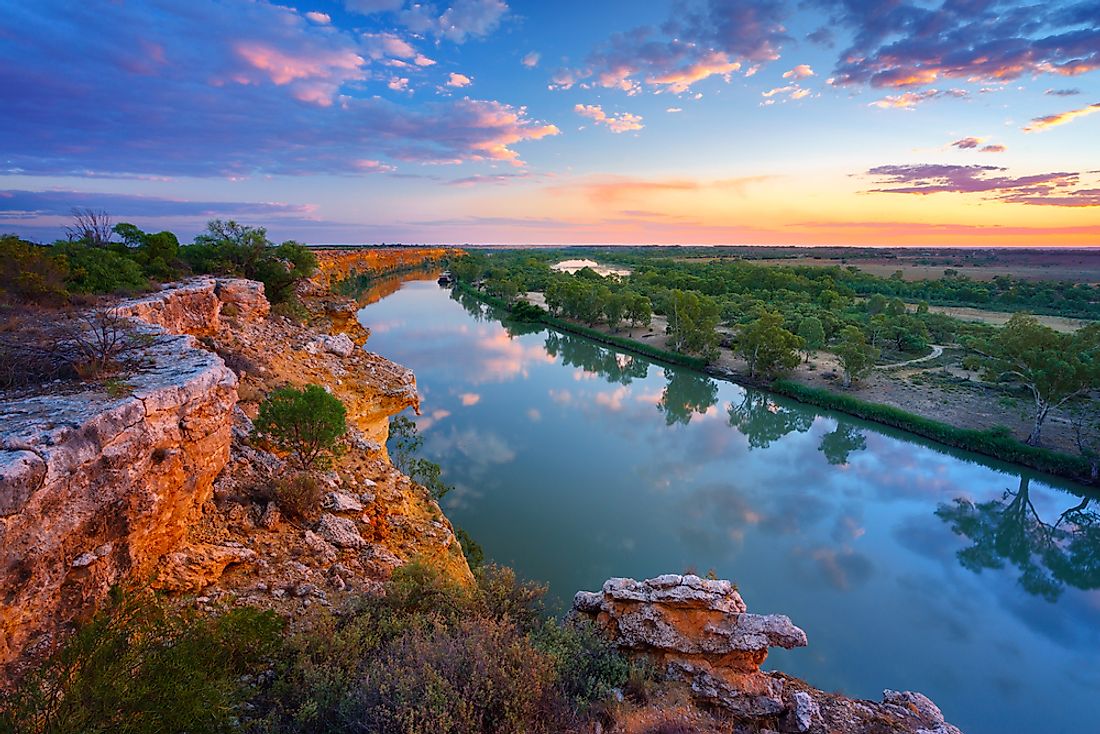The Major Rivers of Oceania

Oceania is one of the largest geographical regions in the world as it spans an area of roughly 3,291,903 square miles. Due to the vast area that the region covers, it encompasses several unique geographical features such as rivers and mountains. Several major rivers flow within Oceania such as the Murray River found in Australia and the Sepik River found in Papua New Guinea. Most of the largest rivers that flow within Oceania are situated in Australia where they play a vital role in the country's economy. Here is a list of the most important rivers in Oceania.
Murray River
The longest river in Oceania is the Murray River which flows for roughly 1,558 miles. The river begins on the southeastern side of the country and flows to the southwestern part of Australia from where it drains into the Indian Ocean. Several fish varieties make their home in the Murray River such as the Murray cod, the Australian smelt, and the Macquarie perch. Several experts have indicated that the Murray River's health has been declining at a fast rate ever since the arrival of Europeans into the country which has resulted in the reduction of fish species in the river. The Murray River is vital for irrigation in several of the regions through which it flows.
Fly River
The largest river in Oceania regarding the volume of its discharge is the Fly River that is situated in Papua New Guinea. The Fly River stretches for a length of roughly 650 miles starting from the Star Mountains and draining in the Gulf of Papua. The Fly River's most important tributaries are the Ok Tedi River and the Strickland River which is the larger of the two. The Fly River is famous because its delta is roughly 62 miles long at its entrance. However, as the delta progresses, its width reduces, and by the time it reaches its apex, it is only 6.8 miles wide. The modern day name for the Fly River traces its roots to the ship HMS Fly which was captained by Francis Blackwood who was the first European to sight the river. The major challenge facing the health of the Fly River is the dumping of mineral waste into its tributaries particularly the Strickland River.
Murrumbidgee River
Another major river in Oceania is the Murrumbidgee River which flows through two Australian states. The river flows for roughly 923 miles before joining up with the Murray River. The Murrumbidgee River is famous because it often floods its banks. The Murrumbidgee's most destructive floods occurred in 1852 and affected Gundagai, Australia resulting in the death of 90 people which at the time was more than 30% of the town's entire population. In the 21st century, the Murrumbidgee's most notable floods occurred in 2010 and 2012.
Darling River
One of Oceania's most famous rivers is the Darling River which flows for roughly 915 miles. For much of Australia's modern history, the Darling River's health has been rapidly deteriorating which is attributed to human activities. The communities that live along the Darling River have contributed to its declining health by constantly polluting it with farm chemicals and industrial chemicals. In the present era, the Darling River has been on the path to recovery mainly due to the 2010 increase in rainfall within its catchment. Experts believe that if the Darling River is to return to its previously healthy state, massive changes need to take place in its long-term management.
Sepik River
New Guinea is home to one of Oceania's most important rivers, the Sepik River, which flows for roughly 700 miles. Several fish species make their home in the Sepik River such as catfish and rainbow fish. It is often claimed that the Sepik River remains the largest uncontaminated water system in the Asia pacific region and several species of fish were introduced into the river since the 1950s. The Sepik River meanders on its course and finally discharges water at its mouth to the Bismarck Sea without a delta. The Sepik is also unique because navigation is possible for most of its length. Due to the large number of meanders that the Sepik River takes, it has formed more than 1,500 lakes most of which have been classified as oxbow lakes. Experts indicated that the Sepik River was one of the few relatively undisturbed rivers in the world because there are few human settlements close to the river.
Cooper Creek
Australia is home to another major river in Oceania, Cooper Creek, that flows for roughly 810 miles. The river is extremely famous because it was where William Wills and Robert Burke died in the 19th century. Charles Stuart gave Cooper Creek its modern-day name in the 19th century, and he named the river after a South Australian chief justice, Charles Cooper. In ancient times, several aboriginal communities lived along the Cooper Creek; however, after the arrival of European settlers, the original inhabitants were displaced from their native lands along the river. Cooper Creek attracted European settlement because it was a reliable water source for both people and animals.
Flinders River
The longest river in the Australian state of Queensland is Flinders River which extends for roughly 624 miles. Flinders River traces its modern-day name to one of the most popular explorers of the late 18th and early 19th centuries, Matthew Flinders. In the ancient period, several aboriginal communities such as the Kalkadoon, Gugu-Badhun, and the Mayi-Kulan lived along the Flinders River. During the 19th century, the Flinders River was the site of significant floods that resulted in the deaths of many people.
The Importance of Rivers in Oceania
Rivers are vital to countries in Oceania since they are used for different purposes such as irrigation and fishing. Due to the importance of the rivers to their economies, the various countries in Oceania have implemented wide-ranging measures to keep their rivers healthy.







